I’m not gonna lie … I decided to write this blog post because I personally didn’t know the differences between quartz vs quartzite 😉.
Like you (and even some designers), I didn’t know what set these two countertop options apart. I just assumed that people called quartz two different names. Well, friend, I was wrong and now I’m sharing everything I learned about what makes quartz and quartzite completely different products.
By the end of this (lengthy, but very informative) blog post, you’ll understand the differences so you can confidently make the best decision for your kitchen … whether that be quartz or quartzite.
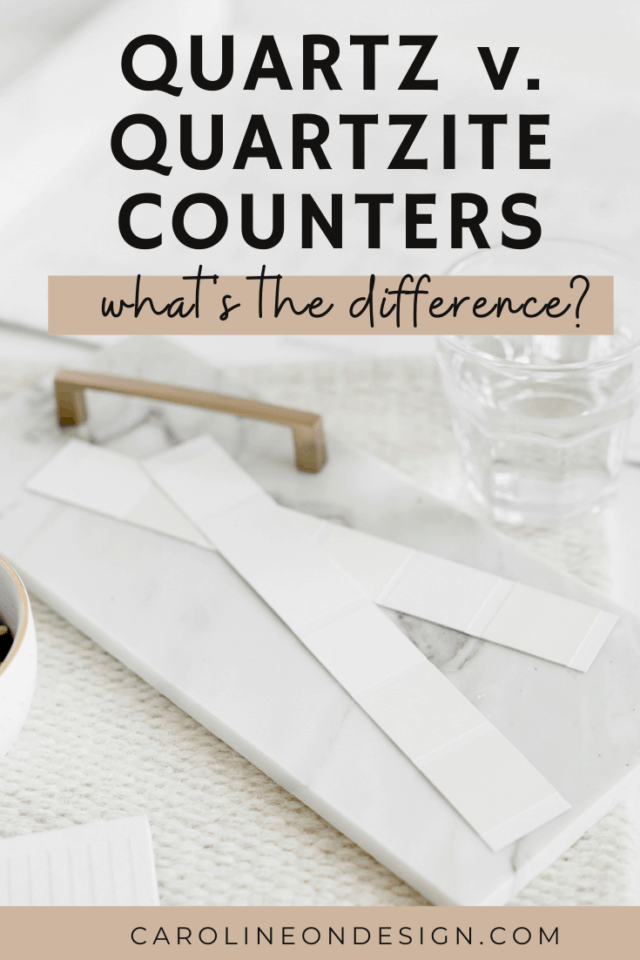
WHAT’S THE DIFFERENCE BETWEEN QUARTZ VS QUARTZITE?
The biggest difference between quartz and quartzite counters is that quartzite is a natural stone whereas quartz is a man-made material.
Quartz countertops are made from engineered stone that is molded into custom shapes. Since this is a man-made product, it is more resilient than quartzite to stains, cracks, and chips. It can be manufactured to look like any stone and you can choose from different shades and patterns.
Quartzite is a fairly hard porous stone that is cut to the exact dimensions you need. Quartzite is often mistaken for marble or granite because it can be found with veining similar to marble or patterns/colors similar to granite.
We’ll get into the nitty-gritty of each option below, but both quartz and quartzite offer durability and outperform granite in terms of hardness.
You might also enjoy HOW TO CHOOSE THE BEST COUNTERTOPS FOR YOUR HOME.
QUARTZ COUNTERTOPS: AN OVERVIEW
Quartz countertops are engineered with the same quartz crystals found in quartzite, but they go through a man-made process that binds the crystals with resins, pigments, and other materials such as glass. This manufacturing process results in a very durable, smooth, non-porous (i.e. it won’t absorb liquids) material that is available in a wide variety of designs and colors (due to the added pigments).
The non-porous surface of quartz serves as an effective barrier against moisture and bacteria which makes staining and bacterial invasions unlikely … all of this without the need for sealing.
Although man-made, quartz countertops can replicate distinct characteristics (i.e. flecks or veining) found in natural stone. On the other hand, these characteristics can be removed entirely from quartz during manufacturing if you prefer a more consistent and uniform look.
With quartzite, you don’t have control over the appearance; you are limited to what pattern is available naturally.
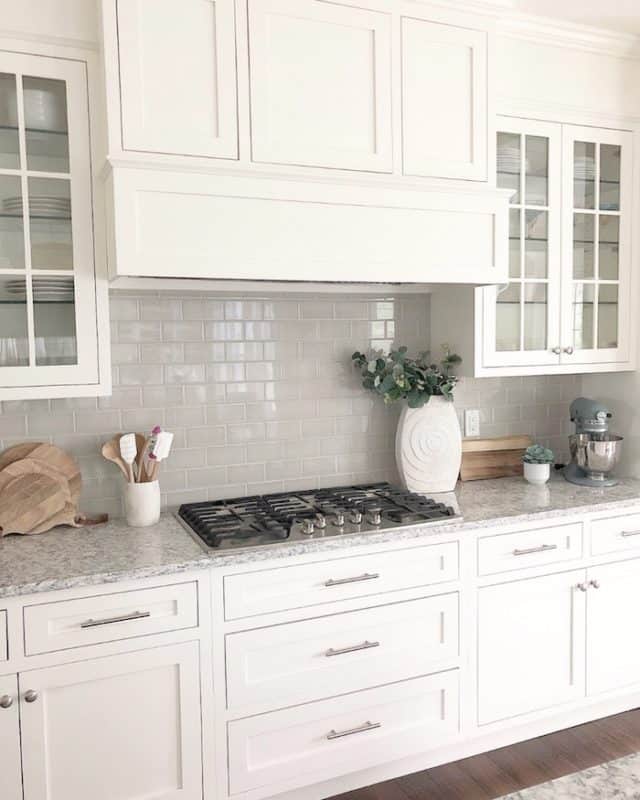
LG Viatera Quartz Countertop in My Kitchen
Quartz requires very little maintenance and you can simply wipe it clean with a water-dampened cloth or paper towel (psst … this is exactly how I clean my own quartz counters). When you do regular cleanings of your counters, make sure to use a cleaner that is safe to use on quartz (i.e. read the label). Abrasive cleaners should never be used on quartz.
Quartz is a tough counter surface, but you do need to be careful. While it is less prone to denting and chipping than quartzite, both countertop materials can be scratched by knives and other sharp objects, so be sure to use a cutting board. Also, quartz does not withstand heat very well (I speak from experience … I burned my quartz counter). Hot pots and pans should never be placed directly on a quartz countertop.
Quartz is an increasingly popular countertop option because it’s beautiful, durable, and very easy to maintain. It can stand up to regular use (other than sharp or hot objects) and is very low-maintenance, especially as compared to quartzite.
Do keep in mind that not all quartz countertops are created equal. Be sure to do your homework and choose a high-quality quartz brand for your kitchen countertops.
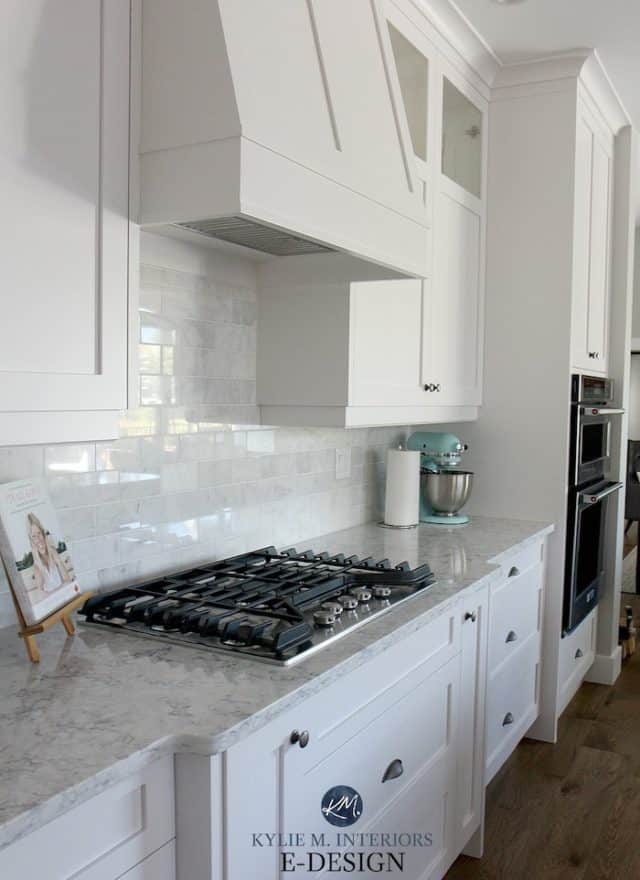
Quartz Countertop via KYLIE M. INTERIORS
QUARTZ COUNTERTOP PROS
- Low-maintenance and easy to clean
- The non-porous surface repels moisture; it won’t absorb spilled liquid
- Doesn’t require sealing every year (it is permanently sealed)
- Manufactured in a wide variety of patterns and colors; can find quartz that resembles natural stones such as granite and marble
QUARTZ COUNTERTOP CONS
- Man-made (this can be a pro or a con depending on your preference)
- Manufacturing can lead to patterns that are more consistent and uniform (again, can be a pro or con depending on your preference)
- Sensitive to heat so you can’t place hot pans or baking dishes directly on a quartz countertop
- Easily scratched by knives or other sharp objects so you need to use a cutting board
QUARTZITE COUNTERTOPS: AN OVERVIEW
Quartzite is a naturally occurring metamorphic rock that is formed from sandstone. It is created when the sandstone is subjected to extreme heat and pressure in the earth’s crust. This stone is mined and later cut into slabs to become quartzite countertops after polishing and sealing the stone.
Because quartzite is a natural stone, it has infinite variations of color and pattern so no two quartzite slabs will look exactly the same.
Quartzite typically comes in shades of white or light grey, but the stone can lend to other hues such as blue, green, yellow, pink, gold, or reddish-brown. It also will have natural streaking, eye-catching patterns, and a slightly coarser feel that give it more of an organic and earthier feel because it is not altered from its natural state.
While quartzite is slightly harder and more scratch-resistant than quartz, you’ll still want to use a cutting board on your countertop. Light chopping will not cause scratching, but heavier knife use should be done on a cutting board.
When it comes to heat, quartzite can take it (unlike quartz). You can place hot baking dishes and hot pans directly on a quartzite countertop; HOWEVER, I recommend that you use a hot pad just to be safe because quartzite can melt (and leave a ring) at very high temps for prolonged periods.
In general, quartzite is a fairly high maintenance countertop option because of its porous surface. Most quartzite must be sealed before use and re-sealed once or twice each year. If not sealed properly, it can soak up liquids which can lead to staining and bacterial invasions. Be sure to read the manufacturer’s recommendations for how to properly seal your quartzite and how often to do this.
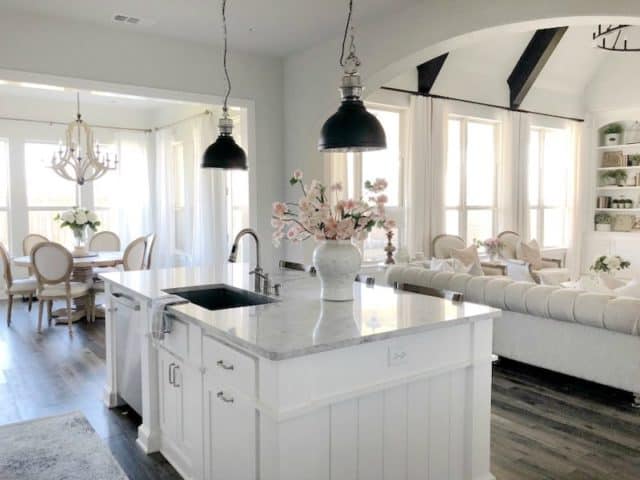
Quartzite Countertop via MY TEXAS HOUSE
QUARTZITE COUNTERTOP PROS
- Natural stone with unique appearance; no two slabs look alike
- More resistance to scratching than quartz
- Can withstand a little bit of heat (but still be careful!)
- Looks and feels more genuine than quartz (because it is!)
QUARTZITE COUNTERTOP CONS
- High maintenance
- A porous surface so requires proper sealing before use and once or twice per year
- Less resistant to staining and bacterial invasions if not sealed properly
- While very strong, they are not indestructible; heavy use can cause scratching
WHAT’S MORE EXPENSIVE? QUARTZ OR QUARTZITE?
Overall, quartz countertops end up costing less than quartzite countertops. However, the cost of the countertops (i.e. the material) is actually quite similar to both quartz and quartzite counters ranging from $60 per square foot up to $100+ per square foot (before installation).
It’s when it comes to installation costs that there is more of a gap between quartzite and quartz.
Because quartzite is a natural stone, it requires custom cutting and more labor-intensive and complex countertop installations which can drastically increase the cost. The more complex the job, the more the cost of quartzite will be higher than that of quartz.
Quartz is more budget-friendly than quartzite, but it is still considered a high-end countertop material and can cost more than natural stone. However, when comparing quartz and quartzite, quartzite is the more expensive option.
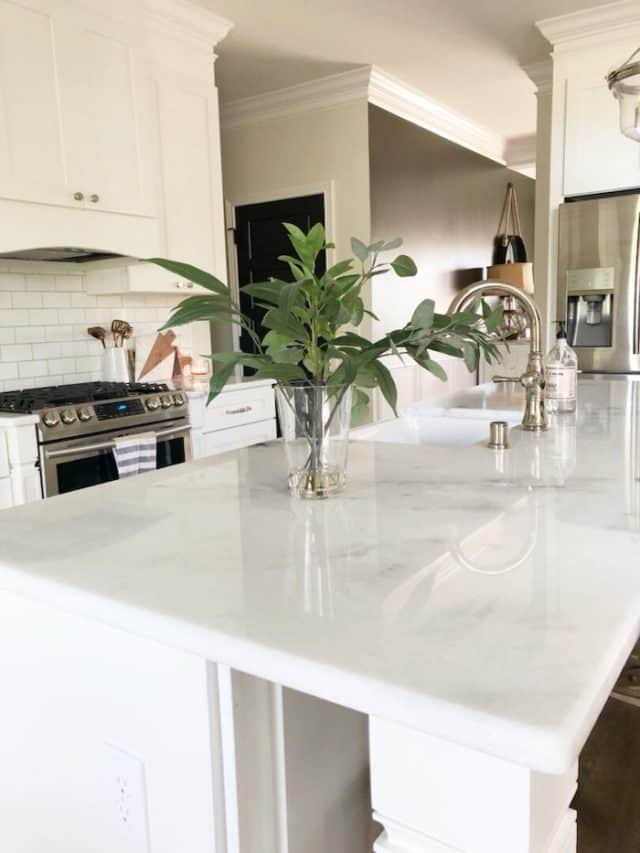
Quartzite Countertop via DECOR KATE
WHICH IS MORE DURABLE? QUARTZ VS QUARTZITE
Both quartz and quartzite each have their ‘pros’ and ‘cons’ when it comes to durability. While quartzite is harder than quartz and allows for some minor heat and cutting directly on the surface, quartz is non-porous and ‘wins’ in the maintenance category.
Below are bullet points that point out each option’s level of durability so you can do a side-by-side comparison.
QUARTZ DURABILITY
- Non-porous so resistant to moisture and doesn’t require sealing
- Less prone to staining and bacterial invasions than quartzite because of the non-porous surface
- Prone to scratching and etching, so can’t cut directly on the counter nor should you place a hot pot/pan directly on the counter
QUARTZITE DURABILITY
- The porous material is not resistant to moisture and spills, so must be sealed properly before use and once or twice per year
- More prone to staining and bacterial invasions than quartz because of the porous surface
- Harder and more heat-resistant than quartz; it can withstand minor knifing and short-term heat (although I still recommend you use a cutting board and heat pad just to be safe)
WHICH IS BETTER? QUARTZ OR QUARTZITE?
It’s always difficult for me to answer the ‘which is better’ question (for any design finish). There is never a right or wrong answer. It simply comes down to what is most important to YOU.
If you love a wide variety of color choices and a consistent pattern in your countertops, then quartz is a better option. If you prefer a natural stone that is completely unique, quartzite is a better option.
If you want a low-maintenance option, then quartz is the better option. If you want a little more durability and don’t mind annual maintenance, then quartzite may be the better option.
If cost is a big factor in your decision, then quartz is the less expensive option.
Again, the ‘which is better’ dilemma all comes down to what factors are most and least important to YOU when it comes to choosing countertops for your home. Both quartz and quartzite are fabulous options; you can’t go wrong with either one!
If you are looking for help with other design dilemmas, grab my *FREE* guided Design Decision workbook to help you confidently make all design decisions for your new (or existing) home!

I currently have granite countertops in my city kitchen. When I start to build my lake house, cost-wise, how does granite compare to Quartz?
Hi Cindy! The cost of granite vs quartz is actually very comparable. However, granite can be slightly higher depending on how high-end a granite product you choose. Also, keep in mind that both granite and quartz are available at various price points and varying levels of quality. Hope that helps! – Carrie
We unknowingly purchased a newly constructed home with unsealed quartzite! We were told by the builder that it was quartz and it did not ever need sealing!!! When we starting seeing horrible stains we went and asked to see the sample piece and gee wouldn’t you know it said “ Quartzite” builder did not know it required different care. 😡
I’m so sorry to hear this, Tweela! I honestly think the majority of people have no idea of the differences between quartz and quartzite. There are some big differences! Unfortunate you are in this situation :(.
Love the picture in this post!
We are redoing the kitchen which is SO outdated.
Can you tell me which LG Viatera quartz you used? I have been looking at that line also.
I am looking for a light gray backsplash for a contrast with soft white cabinets.
Can you tell me the name of the tile you used for the backsplash? So pretty!
Too many decisions!
Thank you for any help you can give!!
Hi Sharyn! You can find all of this info on my Kitchen Sources page on my website.
Just had Quartzite Installed did not no this.
Can you elaborate, Pamela? What is it that you don’t like about the quartzite counters? Your insight will be helpful to other readers :).
How do you seal Quartzite?
Hi Pamela! I am not an expert in quartzite (at all!), so I recommend that you ask a quartzite installer how to properly seal it. Best! Carrie
Excellent info Carrie! I’m very torn between quartz and quartzite. I’m building new home and refuse to install granite. Looking for more relaxed pattern. Either quartz or quartzite will do BUT I have to stay on budget. I’ve decided to mix both. Quartzite for the center island counter and quartz for the back counters. Possibly in matching patterns. I hope it looks unique.
Sounds like a good plan, Irma :).
I used quartzite in my kitchen counters. It was spectacularly beautiful. A polished sample which I tested extensively, showed no damage from all the acids, staining foods, etc. However, I was enticed to have the stone honed, it likely wasn’t properly sealed, and when installed, we quickly discovered that it was incredibly high maintenance. Not for a second could we risk a cut lemon or a blueberry on the counter. Before selling that house, we had professionals clean and seal the countertop which restored its beauty. Never again would I use honed quartzite for a kitchen counter!
Thank you for sharing your experience! Other readers will certainly find your experience helpful :).
Wow! Excellent info on quartz and quartzite.
We have black pearl granite on back counters and want to update the 8×4 island with something new. Carrie, do you think the island is too large to change to quartz or quartzite?
Hi Lisa! I’m not exactly sure what you mean by ‘do you think the island is to large to change to quartz or quartzite?’ Do you mean is it too large cost-wise?
Is our 8’x4’ island (with cooktop) too large to have a different/complementary quartz on it? Our surrounding countertops are black pearl granite. I would like to lighten up the kitchen with an island change.
Your blog has convinced me that we aren’t interested in high maintenance quartzite, so thank you!
Got it! No, I don’t think your island will be too large to have a complementary stone at all!
Based only on the name, people might easily get confused between the two. But their attributes can help tell them apart. I, too, got confused at the start, when I was researching kitchens. But I need a low-maintenance one – the thing that I remembered – and we chose Caesarstone. With a toddler and a baby on the way, something like quartz is a great help.
Quartzite can be tricky; many are very low maintenance (except for annual sealant applied which is the same as granite requirement) but some quartzite is soft; some companies display this difference (the good ones) others don’t. The soft quartzite is similar to marble; will etch easily. Quartz is by far the easiest but looks man made (which it is)
Thank you for sharing this info about quartzite, Terri :).